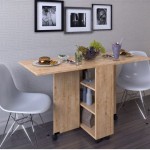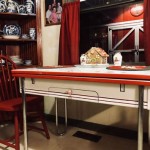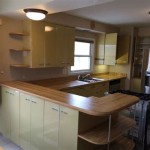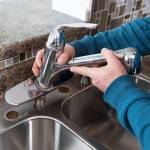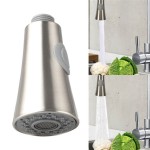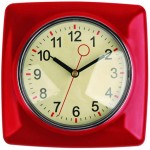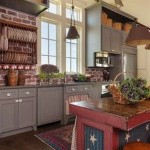Can You Mix Knobs and Handles on Kitchen Cabinets?
The question of whether to mix knobs and handles on kitchen cabinets is a recurring one in interior design discussions. There is no definitive right or wrong answer, as the suitability of combining different types of cabinet hardware hinges on several factors, including aesthetic preferences, kitchen layout, and functional considerations. This article will explore the nuances of mixing knobs and handles, providing insights into how to achieve a cohesive and visually appealing kitchen design.
Cabinet hardware, such as knobs and handles, is more than just a functional element; it serves as a decorative detail that can significantly impact the overall style of a kitchen. The choice of hardware can complement existing design elements, such as cabinetry style, countertops, and backsplash, or it can create a point of contrast and visual interest. The decision to mix or match hardware should be a deliberate one, considering both aesthetic and practical aspects.
One must first understand the specific roles that knobs and handles typically play in kitchen design. Knobs are generally smaller, round or uniquely shaped pieces of hardware that are attached to the cabinet door or drawer with a single screw. Handles, also known as pulls, are longer and often more substantial, usually requiring two screws for attachment. Handles are often favored for their ergonomic benefits, providing a more substantial grip for opening and closing cabinets and drawers.
The debate regarding mixing knobs and handles often stems from a desire to break up the monotony of a uniform look, introduce visual variety, or highlight specific cabinetry elements. Some designers advocate for a consistent approach, believing that uniform hardware creates a sense of order and sophistication. Others argue that mixing hardware adds personality and interest, preventing the kitchen from appearing too sterile or generic. Ultimately, the success of mixing knobs and handles lies in the execution and attention to detail.
Establishing a Cohesive Design Theme
Achieving a harmonious balance when mixing knobs and handles requires careful consideration of several key design principles. One of the most important is establishing a cohesive design theme. While mixing hardware introduces variety, it is crucial to maintain a sense of unity throughout the kitchen. This can be achieved by selecting knobs and handles that share certain characteristics, such as finish, style, or material.
For instance, if one opts for brushed nickel handles, it is advisable to choose knobs with a similar brushed nickel finish. Similarly, if incorporating a particular style, such as contemporary or traditional, the knobs and handles should reflect this aesthetic. Combining sleek, minimalist handles with ornate, vintage-inspired knobs is likely to create a jarring and discordant effect. Instead, focus on hardware that complements each other in terms of overall design and material composition.
Another effective approach is to select knobs and handles from the same product line or collection. Many manufacturers offer coordinating sets of hardware designed to be mixed and matched. These sets often include knobs and handles in a variety of styles and sizes, all sharing a common design language. This ensures a cohesive look while still allowing for subtle variations in hardware selection.
It is also crucial to be mindful of the overall color palette of the kitchen. While mixing hardware finishes can be done successfully, it requires a keen eye and a deep understanding of color theory. Generally, it is best to stick to a limited range of finishes, such as two or three at most, to prevent the kitchen from appearing overly busy or cluttered. If incorporating different finishes, consider how they interact with the other design elements in the room, such as the cabinetry, countertops, and appliances.
Scale and proportion are further important considerations. The size of the knobs and handles should be appropriate for the size of the cabinets and drawers. Using overly large handles on small drawers, or conversely, using tiny knobs on large cabinet doors, can create a visually unbalanced effect. It is often helpful to experiment with different sizes and styles of hardware before making a final decision, either by using sample hardware on existing cabinetry or by creating a mock-up of the kitchen layout.
Strategic Placement of Knobs and Handles
The placement of knobs and handles is another critical factor in determining the success of a mixed hardware approach. Strategic placement can enhance both the functionality and the visual appeal of the kitchen. A common approach is to use knobs on cabinet doors and handles on drawers. This convention can provide a clear visual distinction between different types of cabinetry, making it easier to navigate the kitchen.
However, there are exceptions to this rule. Some designers prefer to use handles on all lower cabinets and drawers, reserving knobs for upper cabinets. This approach can create a sense of visual hierarchy, emphasizing the importance of the lower cabinets while maintaining a clean and streamlined look on the upper cabinets. Another option is to use knobs on all doors and pulls on all wider or heavier drawers, prioritizing function through ease of grip.
For drawers, the size and style of the handle should be proportional to the size of the drawer. Longer drawers, particularly those used for storing pots and pans or other heavy items, typically require larger handles to provide sufficient leverage. Shorter drawers, such as those used for storing silverware or utensils, can be fitted with smaller handles or knobs. Regarding door placement, consider the door's size and the overall design aesthetic. Taller, narrower doors can look elegant with a vertically mounted handle, whereas a small knob might feel more appropriate for a smaller, square cabinet door.
In kitchens with a mix of different cabinet styles or configurations, the placement of knobs and handles can be used to create visual continuity. For example, if one section of the kitchen features shaker-style cabinets and another section features flat-panel cabinets, using the same style of handle throughout can help to tie the two sections together. Similarly, if the kitchen features a mix of drawers and pull-out shelves, using the same style of hardware on both can create a more cohesive look.
The height at which the hardware is installed is also important, ensuring consistent and ergonomic usability. While centering the hardware on the cabinet door or drawer is common, adjustments may be necessary to align with existing architectural features or to create a more visually balanced effect. For example, if the kitchen features a prominent backsplash, aligning the hardware with a particular tile or grout line can create a sense of order and harmony.
Considering Functional Requirements
Beyond aesthetics, it is essential to consider the functional requirements of the kitchen when deciding whether to mix knobs and handles. Different types of hardware offer different levels of grip and ease of use, and the choice of hardware should be tailored to the specific needs of the user.
For individuals with arthritis or other mobility limitations, handles are often a more practical choice than knobs. Handles provide a larger surface area to grip, making it easier to open and close cabinets and drawers. Lever-style handles, in particular, can be a good option for those with limited hand strength, as they require less effort to operate. The placement of the handle is also crucial, ensuring that it is easily accessible and within comfortable reach.
In high-traffic areas, such as the cabinets near the sink or stovetop, it may be wise to opt for durable and easy-to-clean hardware. Stainless steel or other non-porous materials are often a good choice for these areas, as they are resistant to stains and fingerprints. Avoid hardware with intricate details or sharp edges, as these can trap dirt and grime and can be difficult to clean.
The type of cabinet or drawer being used should also be taken into consideration. For example, drawers that are used for storing heavy items, such as pots and pans, may require larger and more robust handles to provide adequate support. Similarly, cabinets that are frequently used may benefit from hardware that is comfortable to grip and easy to operate. Consider how the cabinets are used on a daily basis and choose hardware that reflects these needs.
Finally, it is important to factor in the age and durability of the cabinetry. Older cabinets may require different types of hardware than newer cabinets, particularly if the existing hardware has left holes or marks. In these cases, it may be necessary to choose hardware that covers the existing holes or that can be easily installed without causing further damage to the cabinetry. It is always a good idea to consult with a professional cabinet installer or hardware specialist to ensure that the chosen hardware is compatible with the existing cabinetry.

How To Mix And Match Your Kitchen Cabinet Hardware

Top Tips For Mixing And Matching Kitchen Cabinet Hardware

How To Mix And Match Your Kitchen Cabinet Hardware

How To Mix And Match Your Kitchen Cabinet Hardware

How To Mix And Match Your Kitchen Cabinet Hardware

How To Mix And Match Cabinet Hardware Sprucing Up Mamahood

How To Mix Match Kitchen Hardware Finishes Styles The Inspired Room

How To Mix Kitchen Cabinet Hardware Knobs And Pulls Porch Daydreamer

How To Mix Cabinet Hardware Mockett

How To Choose Between Knobs Or Pulls On Kitchen Cabinets
Related Posts

